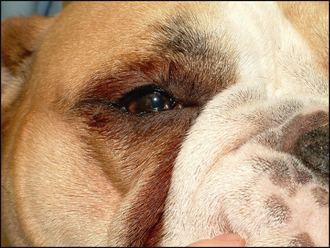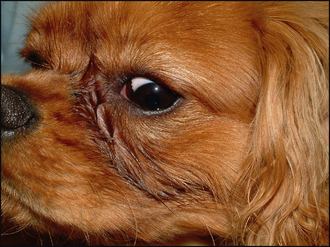17 Chronic epiphora
CLINICAL EXAMINATION
General clinical examination is typically unremarkable. On ophthalmic examination the obvious abnormality is a wet face – tear overflow from the medial canthus runs down the side of the nose (Figure 17.1). Often there is dark staining (as the presumed lactoferrin-type pigments in tears react with the atmosphere), and some localized skin inflammation and moist dermatitis can be present. It is essential to determine whether the tear overflow is purely due to poor drainage (i.e. epiphora) or to increased lacrimation. Sometimes a combination of both can be present. However, if Schirmer tear test readings are normal and there is no evidence of ocular discomfort, then epiphora can usually be assumed.
Examination for conditions which could cause irritation and increase tear production slightly should be undertaken. Thus the presence of nasal folds rubbing on the cornea or conjunctiva, distichia or ectopic cilia, overt entropion or corneal ulcers should be noted (Figure 17.2). In most cases of pure epiphora these latter abnormalities are not present and the rest of the ophthalmic examination is normal.

Figure 17.2 Epiphora and increased lacrimation in a young English bulldog. In addition to the tear staining at the medial canthus this dog is wet around the lateral canthus (unlike Figure 17.1) and some lower lid entropion is present causing increased tear production rather than the dog just having poor drainage. Schirmer tear test readings would be high in this dog, but normal in the CKCS in Figure 17.1.




